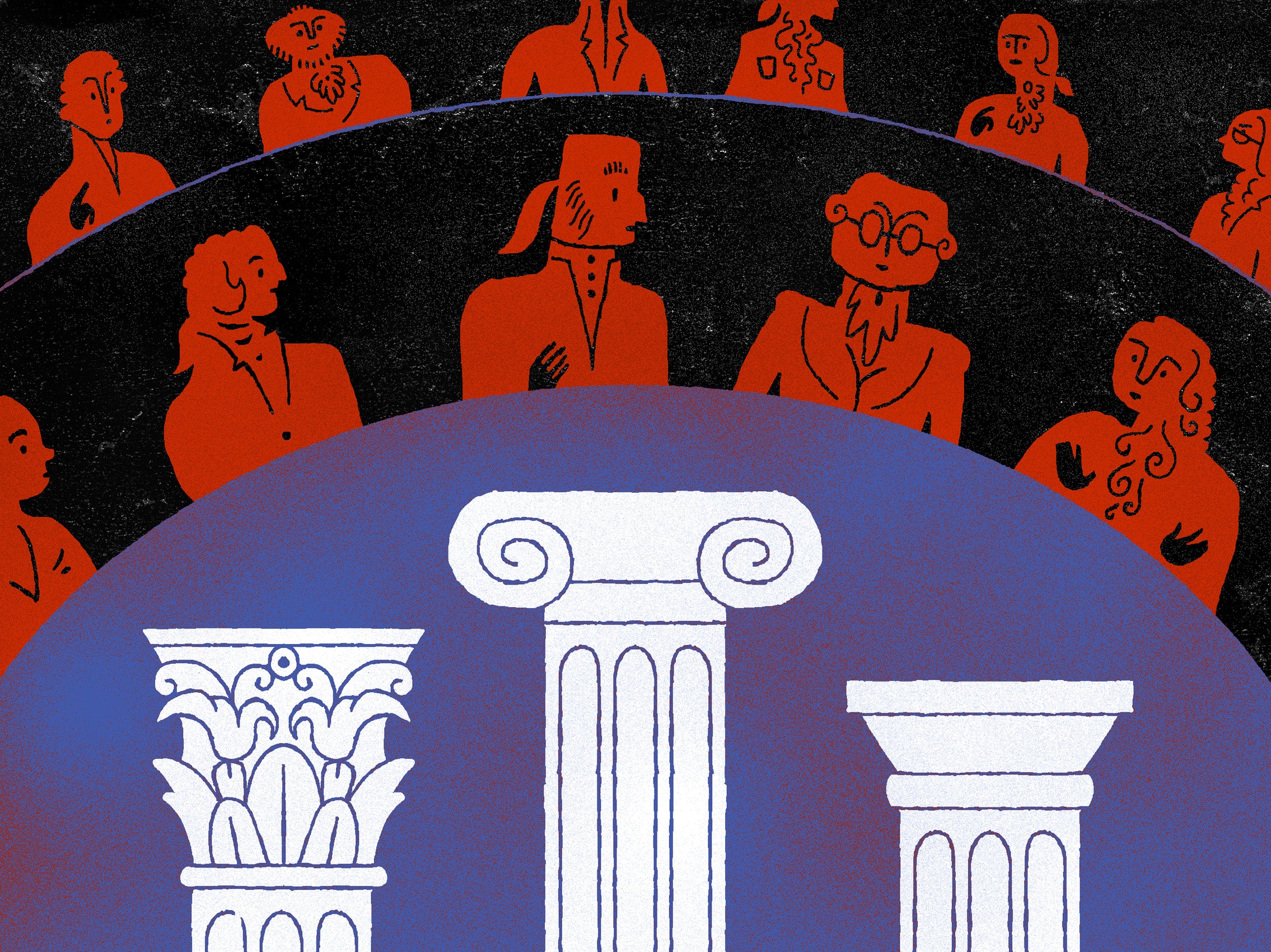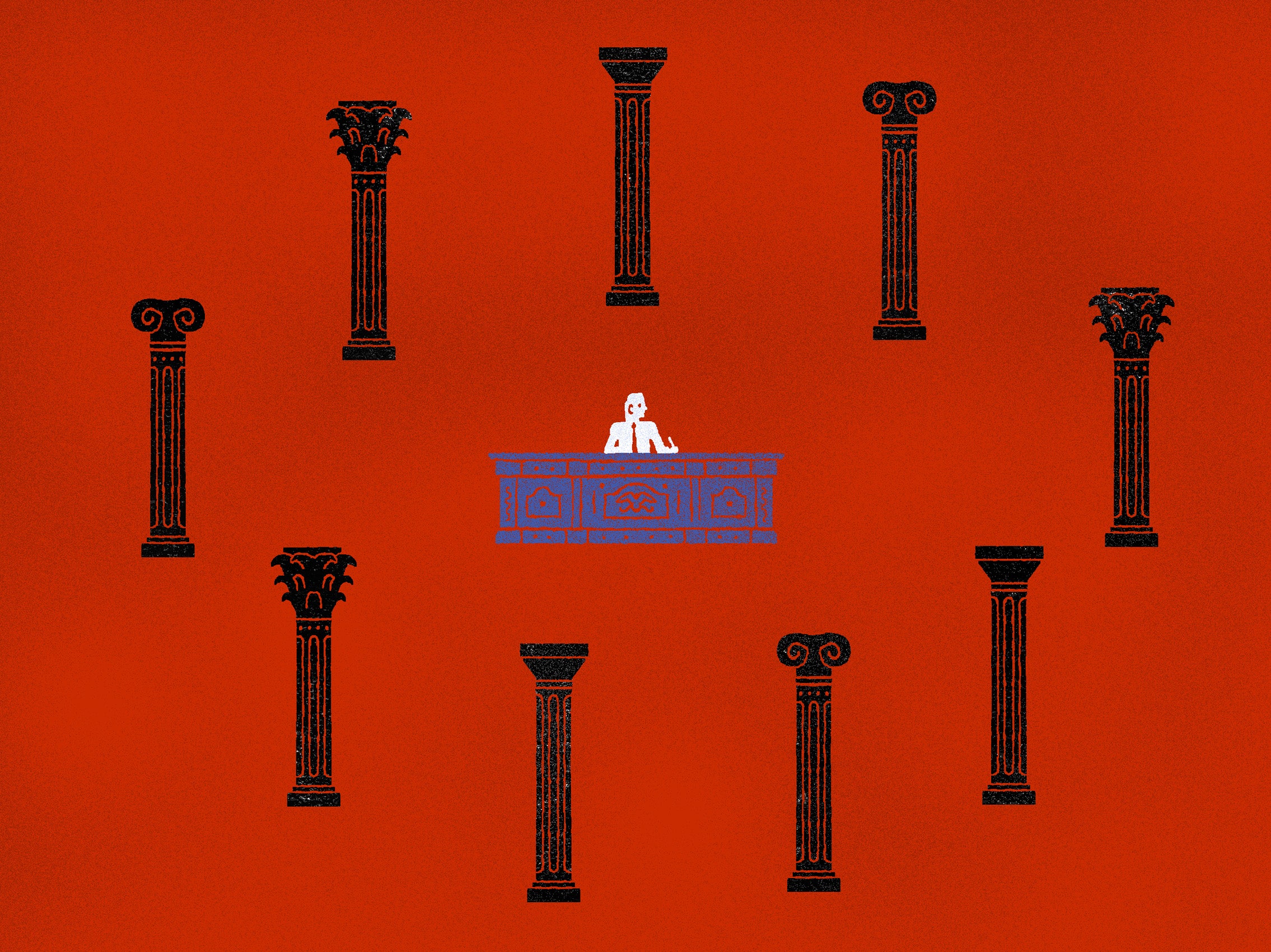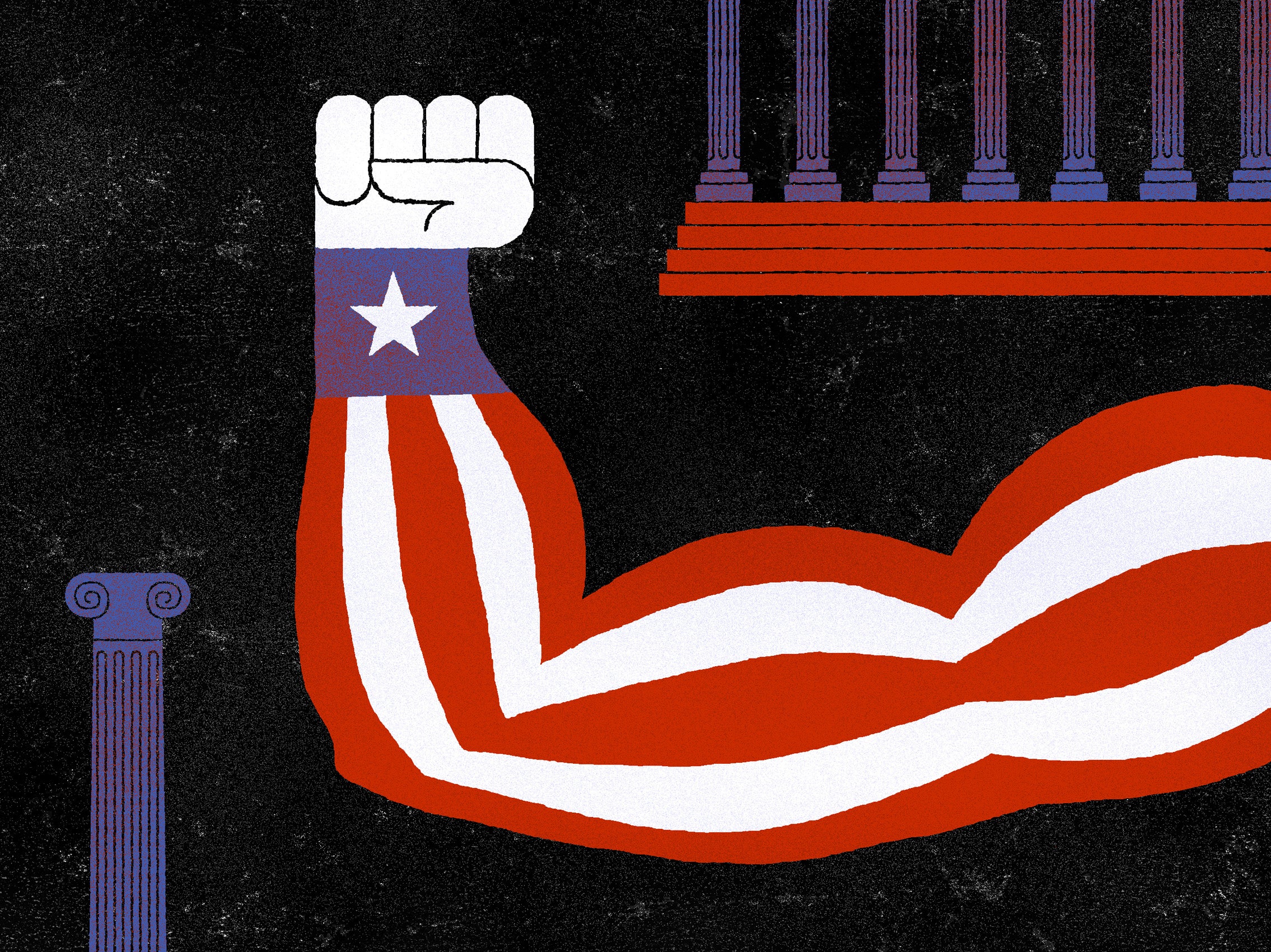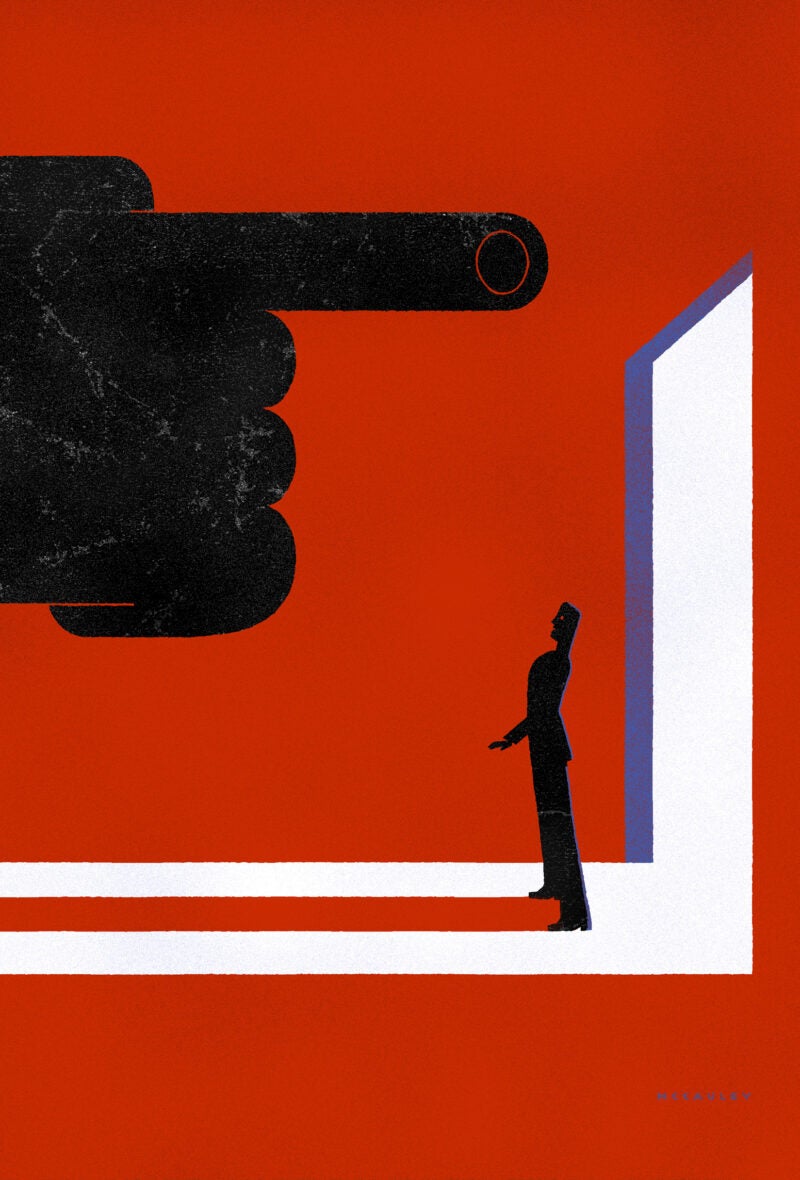The new president was on a mission. He’d been elected on a promise to radically reshape the national government, a vow he intended to keep, even if it meant having to purge ideological opponents from the federal bureaucracy.
He wasn’t the first chief executive to embrace the president’s power over the executive branch. Like others before him, he immediately removed political rivals from high-ranking department roles, installing instead his own hand-picked cabinet officials to serve as secretaries of state, labor, and treasury, and in other high-level positions.
But the president was willing to press the boundaries of his authority further. Although Congress had intended to insulate some civil servants from political meddling, the president nonetheless fired one such individual, leading to a groundbreaking fight that would ultimately end at the Supreme Court of the United States.
The president, of course, was Franklin Delano Roosevelt, and the clash he precipitated in 1933 eventually led to a Supreme Court decision that would cement for nearly a century Congress’ ability to protect executive branch employees from presidential control.
The debate about whether
the president can fire
anyone who exercises
executive authority is a
longstanding one.
The question of who the president can fire in the executive branch has implications beyond who fills a particular position — it involves the power to control the actions and decision-making of that branch of government, which includes major departments, commissions, regulatory boards, and independent agencies.
Today, as the president again seeks to wield significant control over the federal government, some members of the Supreme Court appear to adopt a different constitutional theory of executive power from the one that animated the case involving Roosevelt, Humphrey’s Executor v. United States.
In fact, the Court has signaled that it may be prepared to rethink its approach to the presidential removal power entirely. If it chooses to do so, it could change the relationship of the president to the administrative state — one that has been in constant flux since the nation’s founding.
The (In)Decision of 1789
The source of the president’s power under the U.S. Constitution is unequivocal, at least to a certain extent, argue Harvard Law School Professors Cass Sunstein ’78 and Adrian Vermeule ’93 in their 2021 article “The Unitary Executive: Past, Present, Future,” published in the Supreme Court Review.
Article II, which establishes the executive branch, states: “The executive Power shall be vested in a President of the United States of America,” and goes on to specify that this chief executive “shall take Care that the Laws be faithfully executed.”
“Those words do not seem ambiguous,” write Sunstein and Vermeule. “Under the Constitution, the president, and no one else, has executive power.”
Article II also requires the president to obtain the advice and consent of the Senate to appoint certain officeholders, such as department heads. But from there, things get murkier, says Sunstein, the Robert Walmsley University Professor at Harvard.
“The Constitution itself is ambiguous on the power of removal, and the debate about whether the president has a constitutional right to fire anyone who exercises executive authority — that’s a longstanding one,” he says.
So longstanding, in fact, that it arose during George Washington’s time in office. As the First U.S. Congress convened to create the nation’s first executive branch departments — Treasury, War, and Foreign Affairs (soon afterward renamed the Department of State) — members debated whether the president should have unfettered authority to remove agency heads.
Some contemporaries, such as Rep. Alexander White of Virginia, believed that, because the Constitution required the Senate’s input on appointments, so too should Congress have a role in dismissals. Georgia Rep. James Jackson worried that unilateral authority to remove cabinet officials could be dangerous or corrupting to the new republic.
But other central figures, particularly Alexander Hamilton and James Madison, felt the president should have sole dominion over these roles. This responsibility, Madison said, “will make him, in a peculiar manner, responsible for [executive branch officials’] conduct. … ”
Eventually, in what is referred to by scholars as the Decision of 1789, Congress granted the president authority to remove the leadership of the three original departments on his own. But Sunstein argues that it is difficult to draw conclusions about the founders’ views on broader removal power from the outcome.
“In the debate that led to the Decision of 1789, the idea that the Constitution grants the president the authority to fire anyone who exercises executive authority was visible,” he says. “But it looks like it didn’t command the majority.”

The Supreme Court seemed to accept some limits to the president’s removal power a little over a decade later, when it decided Marbury v. Madison (1803), argues Lawrence Lessig, Roy L. Furman Professor of Law and Leadership at Harvard, in a post on Substack in May. Lawyers and legal scholars remember the case for its importance in establishing judicial review, but Chief Justice John Marshall also wrote that President Thomas Jefferson had not, in fact, been entitled to remove William Marbury, one of President John Adams’ “midnight judges.” With this line of reasoning, Lessig writes, the Court “rejected [a] key part of the maximalist theory of executive power.”
Part of ‘a general intellectual movement’
Americans of the post-Civil War era do not seem to have agreed on the extent of the president’s removal power either. The debate flared up again when revanchist politicians — including President Andrew Johnson — attempted to thwart Reconstruction, which had begun under Abraham Lincoln. Fearing that Johnson would fire Secretary of War (and Lincoln appointee) Edwin Stanton, Republicans in Congress passed the Tenure of Office Act to bar the president from removing certain executive branch officials without Senate approval. Ignoring the law, Johnson dismissed Stanton anyway, leading to Johnson’s impeachment by the House of Representatives — and narrow acquittal by the Senate. Approval of the law was split along party lines, and it was repealed 20 years later.
Then came the growth of the administrative state. At the close of the 19th century, Progressive Era reformers, responding to a rapidly changing nation, pushed for the creation of new, expert-driven agencies to address problems caused by industrialization and urbanization, says Mark Tushnet, William Nelson Cromwell Professor of Law Emeritus.
This included bodies to investigate corporate malpractice and ensure the safety of food, drugs, and workplaces, along with the first “independent” agencies, which, by virtue of Congress’ statutory framing, enjoyed some degree of separation from the White House. In 1887, Congress established the Interstate Commerce Commission to regulate the railroads and, for the first time, included in the enabling act an explicit statutory provision that the president could not remove its commissioners except for inefficiency or a related reason. Tushnet says it is not a coincidence that this early independent agency came about alongside “a general intellectual movement in favor of what came to be thought of as scientific decision-making.”
Farmers, who felt they were being taken advantage of by railroad monopolies, pushed for a nationwide body to determine fair pricing, he explains. “Ratemaking was thought to be something that could be done, and should be done, objectively, rather than under the influence of politics. An agency that was expert but not politically controlled was thought to be the way to go.”
This was also a time in which a professionalized civil service began to replace political appointments at the lower levels of the federal bureaucracy, Tushnet adds. “There’s this intellectual atmosphere that a large part of government involves application of expertise to public policy problems, rather than merely political solutions to those problems.”
Today, there are around 80 agencies that could be considered independent, according to the Sourcebook of United States Executive Agencies. But Sunstein, who served as administrator of the White House Office of Information and Regulatory Affairs from 2009 to 2012, argues that such agencies have never had complete free rein. “They have to answer to the courts; Congress controls their budgets. The president appoints them, and so they are connected to the president’s will in that way,” he says.

Like the members of the Interstate Commerce Commission, officials at modern independent agencies can also be removed by the president for cause, Sunstein adds. “Under the longstanding status quo, the president can fire people at independent agencies for inefficiency, malfeasance, or neglect, and on one view, that gives the president considerable authority.”
The postmaster and the president
The Supreme Court next weighed in on the president’s power of removal as the administrative state continued to expand into the 20th century. In 1926, the Court decided a case involving President Woodrow Wilson’s firing of a high-level postmaster in contravention of a federal law stating that the president could remove only certain postmasters and only with the advice and consent of the Senate.
In Myers v. United States, the Court endorsed a strong view of the chief executive’s authority. “The vesting of the executive power in the President was essentially a grant of the power to execute the laws,” wrote Chief Justice William Howard Taft, who as a former president brought to the bench a unique perspective on the question.
Taft, examining the Decision of 1789 closely, concluded that the founders intended the president to have control over removals, an understanding, he writes, that had informed long-accepted practice in the federal government, “ … because this was the decision of the First Congress, on a question of primary importance in the organization of the Government, made within two years after the Constitutional Convention and within a much shorter time after its ratification; and … because that Congress numbered among its leaders those who had been members of the Convention. It must necessarily constitute a precedent upon which many future laws supplying the machinery of the new Government would be based, and, if erroneous, it would be likely to evoke dissent and departure in future Congresses.”
Sunstein notes that Taft’s opinion suggested that officials whose duties are strictly of a quasi-judicial nature might be treated differently. He also notes that the Court accepted some limits of the president’s authority over the executive branch more generally. “Even in Myers, which seems to embrace the unitary executive view in its strongest forms, the Court said that the president doesn’t have unlimited directive authority,” he says.
While the modern-day Supreme Court has recently relied on the Myers decision in several cases, Tushnet argues that Myers was “just a blip” at the time it was decided.
“Myers just seemed like it was the product of a particular moment. It was contested, and it was written by a former president and so was taken to be an expression of his personal views of the presidency,” Tushnet says. “And relatively quickly after it was decided, the Court started to confine its scope to authorize long-term, term-based appointments to positions of significant policymaking authority.”
One of those cases, Humphrey’s Executor v. United States, came just nine years later, as FDR began to implement his New Deal agenda, including a slew of legislation that was designed to address the Great Depression by developing a more muscular administrative state.
William E. Humphrey was a conservative member of the Federal Trade Commission, an independent agency whose members are appointed by the president for a term and subject to removal only for cause. When Humphrey refused Roosevelt’s request to resign, the president fired him.
When the case landed at the Supreme Court, the justices seemed to tiptoe away from Myers, drawing a distinction between agencies and officials whose functions are purely executive, like the secretary of state or the Department of Defense, and those, such as the FTC or the National Labor Relations Board, that engage in rulemaking or dispute resolution, for example. The latter, the Court said, could legitimately be shielded to some degree from the president’s control.
“Humphrey’s Executor was a correction to Myers, or an effort to figure out a way of reconciling what were very well-established forms of governance in the independent agencies with the Myers idea,” says Tushnet. “And the form of reconciliation was in saying that these agencies engaged not in purely executive action, but quasi-legislative and quasi-judicial actions.”
Ironically, losing the case boosted FDR’s policies in the end, Tushnet contends. “Although the particular decision went against Roosevelt, it effectively validated the Progressive and then the New Deal program of governing through independent agencies.”
In a series of decisions over the decades that followed Humphrey’s Executor, the Court continued to uphold limitations to the president’s removal power, including with respect to officials performing quasi-judicial tasks and independent counsel. These decisions joined an older precedent that protected many lower-level civil servants from presidential discretion. Congress, it seemed, could shield some executive branch officials, even as the chief executive retained removal authority over everyone else.
But by the early 1980s, a competing constitutional theory was gaining steam.
The unitary executive theory
According to Sunstein, while there have always been advocates of a strong presidency, a more formalized legal framework for interpreting the bounds of the president’s authority began gaining popularity during Ronald Reagan’s administration.
Associated with scholars such as Steven G. Calabresi of Northwestern Pritzker School of Law and Christopher S. Yoo of Penn Law School, the unitary executive theory found purchase in the opinions of jurists including Justice Antonin Scalia ’60.
Today, there are around 80 executive agencies that could
be considered independent,
but some argue they have
never had complete free rein.
In the 1988 case, Morrison v. Olson, the Court further expanded its Myers carve-outs, finding constitutional a statute that empowered the judicial branch to appoint an independent counsel who is unremovable by the president. In a fiery dissent, Scalia articulated the unitary executive theory’s key principle: That the Constitution gives the president full, unbroken control over the executive branch. Referring to Article II, Scalia wrote: “[T]his does not mean some of the executive power, but all of the executive power.”
Despite a growing number of adherents, the theory is somewhat amorphous, with scholars differing on the exact boundaries of the president’s power not only to fire officials, but to direct their actions, and to determine what it means to “faithfully execute” the law. As Jack Goldsmith, Learned Hand Professor of Law, told the Lawfare podcast in February, “There’s no canonical definition” of the theory.
In a particularly comprehensive version, the president may fire at will anyone who exercises executive authority and can also direct them to decide as he thinks best. Adrian Vermeule, Ralph S. Tyler, Jr. Professor of Constitutional Law, articulated this maximalist conception in a post on Substack in July 2024, likening the presidency to Thomas Hobbes’ idea of “Leviathan,” wherein employees of the administrative state are inseparable from the chief executive himself and “exercise not their own power, but that of the president.” Accordingly, Vermeule wrote, “A subordinate officer who refuses an authorized presidential command acts incoherently, as though the hand attempted to revolt against the head and the body.”
Others believe in a “weaker” unitary executive theory, according to Sunstein. In his view, the best understanding of history supports a construction which generally holds that there are some functions that are constitutionally assigned to the president, over which he or she must retain full control — such as foreign affairs and law enforcement — and others that are more independent.
Harvard Law Professors Nikolas Bowie ’14 and Daphna Renan view presidential authority very differently, arguing that prior to Reconstruction, Congress and the chief executive were in continual negotiation over the balance of powers as a natural result of the democratic process. In “The Separation-of-Powers Counterrevolution,” a 2021 article in The Yale Law Journal, they contend that a true historical approach to determining the limits of the president’s power would require that the courts defer to “the political process of lawmaking.”
Justice Elena Kagan ’86, in her dissenting opinion in Seila Law LLC v. Consumer Financial Protection Bureau, seemed to express a similar sentiment. “Throughout the Nation’s history, this Court has left most decisions about how to structure the Executive Branch to Congress and the President, acting through legislation they both agree to,” wrote the former Harvard Law School dean.
The end of independence?
Today, the Court appears receptive to some of the ideas of the unitary executive theory — including the robust presidency as imagined in Myers,with an extensive power of removal. In Seila Law, decided in 2020, the Court, without formally overruling precedents such as Humphrey’s Executor, invalidated the structure of the Consumer Financial Protection Bureau, which had been created by Congress to address the fallout of the 2008 financial crisis.
Because the agency is led by a single individual — not a group of people — it “lacks a foundation in historical practice and clashes with constitutional structure by concentrating power in a unilateral actor insulated from Presidential control,” wrote Chief Justice John Roberts ’79 in his majority opinion.
Although the case focused on only the CFPB, Sunstein and Vermeule, in “The Unitary Executive,” mused shortly afterward that the Court’s decision hinted that a more thorough reconsideration of presidential removal power was to come.
“There are significant strands of the Court’s opinion that seem far more ambitious,” they wrote, adding that the Seila Court acknowledged just two exceptions to the president’s removal power: “inferior officers with limited duties” and “multimember expert agencies that do not wield significant executive power.”
Some believe the Court
should think carefully about overruling nearly a century
of precedent respecting independent agencies.
This prediction has now perhaps been validated. In two emergency docket decisions this past term, the Court telegraphed that it may be ready to revisit Humphrey’s Executor. In Wilcox v. Trump, the justices considered whether to uphold the temporary reinstatement of a member of the National Labor Relations Board, whom President Donald Trump had fired without cause. In an unsigned opinion, the Court declined to prevent the member’s removal while the case makes its way through the lower courts, writing that the NLRB isn’t likely to fall within the slim category of exceptions to the president’s control over the executive branch, because it “exercise[s] considerable executive power.”
As the new term begins, the Court seems more open about its willingness to revisit longstanding precedent, according to Sunstein. Intriguingly, the Court in Wilcox took care to distinguish the Federal Reserve System from other independent agencies.
“In poker, that’s called a ‘tell,’” Sunstein says. “They probably wouldn’t have done that unless they knew that people saw the case as a strong signal that the independence of other independent agencies was in jeopardy.”
But he adds that the Court need not overrule Humphrey’s Executor entirely to permanently change how some agencies function. The Court could also limit the 1935 case to its facts — that of a smaller FTC that was, at the time, mostly an adjudicative body. Such a narrow reading of the case would have the effect of “jeopardizing independent agencies,” he says.
‘Purely political creatures’
What would the overruling of Humphrey’s Executor mean for the modern administrative state? As Sunstein points out, the majority of departments and agencies today are not independent and thus would not be affected.
For independent agencies, he argues, limiting Humphrey’s Executor would be “significant, but less significant than it may appear.” Even with existing protections for officials and their decision-making, these agencies already “end up lining up with the political convictions of the president.”
But to Tushnet, the demise of Humphrey’s Executor would mean the end of a tradition, rooted in the Progressive Era, of a federal government strengthened by expert-backed decision-making. “These agencies would become purely political creatures,” he argues, “with any notion of expertise out the window.”
Like Tushnet, Sharon Block, a professor of practice and executive director of Harvard Law’s Center for Labor and a Just Economy, believes that such a change could have a serious negative effect on independent agencies such as the National Labor Relations Board. To Block, there is value in respecting Congress’ aim of protecting people’s interests from political whims, particularly in the employment context.
“You don’t want someone to be able to say, ‘Well, this person is a Republican or a Democrat, so they don’t deserve back pay if the law has been violated,’” says Block, who served on the board during the administration of Barack Obama ’91.

Under current law, NLRB members can be removed only for cause. Despite this restriction, Block believes that the president still maintains a significant amount of control over the body, because he or she controls who serves as the agency’s top prosecutor and who fills vacant seats. But once members are appointed to the board, Block thinks some degree of protection for them makes sense.
“Independence means that, once you have been confirmed by the Senate, you can’t be removed by the president for deciding the case in a way that doesn’t align with their view of things,” she says.
Block maintains that the end of Humphrey’s Executor would mean more than whether the president can remove members of agencies like the NLRB. “Congress passed these statutes believing the president couldn’t remove members without cause. It chose this form of agency based on a longstanding view that members would be protected from political influence. If that goes away, is this how we should be enforcing labor law moving forward?”
She thinks that such a decision might even wind up weakening the executive branch, even as it shifts power to the chief executive. “To take away a tool from Congress that allows it to find the best way to structure enforcement and implementation of the law diminishes the executive branch,” Block says. “It makes it so much harder to govern in complicated times.”
Sunstein, like Block, believes that the Court should think carefully about overruling nearly a century of precedent respecting independent agencies. “I’m drawn to the view that it would take a very heavy burden of justification to reject law that’s been settled for 90 years, and that that burden of justification hasn’t been met,” he says. “I’d do so not on thoroughly originalist grounds, but on respect for precedent.”
As Sunstein says, the Court has hinted that it may soon have an answer to this debate which has simmered under the surface of American democracy since its founding. And yet, if history is our guide, discussion and disagreements about the limits of executive branch authority may continue for decades, or even centuries, to come.
